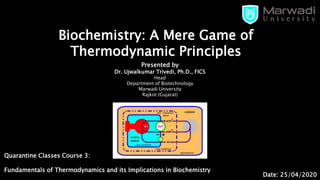
Biochemistry a mere game of thermodynamic principles
- 1. Presented by Dr. Ujwalkumar Trivedi, Ph.D., FICS Head Department of Biotechnology Marwadi University Rajkot (Gujarat) Biochemistry: A Mere Game of Thermodynamic Principles Date: 25/04/2020 Quarantine Classes Course 3: Fundamentals of Thermodynamics and its Implications in Biochemistry
- 2. Bioenergetics is a field in biochemistry and cell biology that concerns energy flow through living systems. This is an active area of biological research that includes the study of the transformation of energy in living organisms and the study of thousands of different cellular processes such as cellular respiration and the many other metabolic and enzymatic processes that lead to production and utilization of energy in forms such as adenosine triphosphate (ATP) molecules. That is, the goal of bioenergetics is to describe how living organisms acquire and transform energy in order to perform biological work.[4] The study of metabolic pathways is thus essential to bioenergetics.
- 3. High ΔH and Low ΔS Low ΔH and High ΔS
- 4. Dissipative structures are open systems, they need a continual input of free energy from the environment in order to maintain the capacity to do ‘work’. It is this continual flux of energy, into and out of a dissipative structure, which leads towards self- organization and ultimately the ability to function at a state of non- equilibrium.
- 5. (Just like the convection of water, biological organisms are also self- organizing dissipative structures, they take in and give off energy from the environment in order sustain life processes and in doing so function at a state of non-equilibrium. Although biological organisms maintain a state far from equilibrium they are still controlled by the second law of thermodynamics. Like all physiochemical systems, biological systems are always increasing their entropy or complexity due to the overwhelming drive towards equilibrium. But, unlike physiochemical systems, biological systems possess ‘information’ that permits them to self-replicate and continuously amplify their complexity and organization through time.
- 6. If you take a thin layer of water, at uniform temperature, and start heating it from the bottom, a strange ordered structure begins to appear. As the temperature between the bottom and top of the water reaches a critical level, the water begins to move away from an equilibrium state and an instability within the system develops. At this point, convection commences and the dissipative structure forms. As heat is transferred through the liquid, a patterned hexagonal or ‘honey combed’ shape emerges (Bénard cells) and the capacity to do ‘work’ is realized (life). But, as soon as the energy source (heat) is taken away, the ordered pattern disappears and the water returns to an equilibrium state (death).
- 7. Although the chemical composition of an organism may be almost constant through time, the population of molecules within a cell or organism is far from static. Molecules are synthesized and then broken down by continuous chemical reactions, involving a constant flux of mass and energy through the system. The hemoglobin molecules carrying oxygen from your lungs to your brain at this moment were synthesized within the past month; by next month they will have been degraded and replaced with new molecules. The glucose you ingested with your most recent meal is now circulating in your bloodstream; before the day is over these particular glucose molecules will have been converted into something else, such as carbon dioxide or fat, and will have been replaced with a fresh supply of glucose. The amount of hemoglobin and glucose in the blood remains nearly constant because the rate of synthesis or intake of each just balances the rate of its breakdown, consumption, or conversion into some other product. The constancy of concentration does not, therefore, reflect chemical inertness of the components, but is rather the result of a dynamic steady state.
- 9. The downward motion of an object releases potential energy that can do work. The potential energy made available by spontaneous downward motion (an exergonic process, represented by the pink box) can be coupled to the upward movement of another object (an endergonic process, represented by the blue box). A spontaneous (exergonic) chemical reaction (B→C) releases free energy, which can pull or drive an endergonic reaction (A→B) when the two reactions share a common intermediate, B. The exergonic reaction B→C has a large, negative free- energy change (ΔGB→C), and the endergonic reaction A→B has a smaller, positive free-energy change (ΔGA→B). The free-energy change for the overall reaction A→C is the arithmetic sum of these two values (ΔGA→C). Because the value of ΔGA→C is negative, the overall reaction is exergonic and proceeds spontaneously.
- 11. Activation energy can be thought of as the magnitude of the potential barrier (sometimes called the energy barrier) separating minima of the potential energy surface pertaining to the initial and final thermodynamic state. For a chemical reaction, or division to proceed at a reasonable rate, the temperature of the system should be high enough such that there exists an appreciable number of molecules with translational energy equal to or greater than the activation energy. A substance that modifies the transition state to lower the activation energy is termed a catalyst; a catalyst composed only of protein and (if applicable) small molecule cofactors is termed an enzyme. A catalyst increases the rate of reaction without being consumed in the reaction. In addition, the catalyst lowers the activation energy, but it does not change the energies of the original reactants or products, and so does not change equilibrium. Rather, the reactant energy and the product energy remain the same and only the activation energy is altered (lowered).
- 14. Because the concentrations of the direct products of ATP hydrolysis are, in the cell, far below the concentrations at equilibrium mass action favors the hydrolysis reaction in the cell.
- 17. Total: 686 kcal/mol 234 kcal/mol trapped Almost nothing is trapped
- 18. Thank You Kindly Reach us at: Marwadi University Rajkot-Morbi Highway Road, Gauridad, Rajkot, Gujarat 360003 Website: https://www.marwadieducation.edu.in/